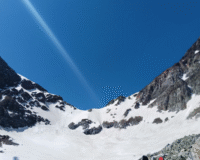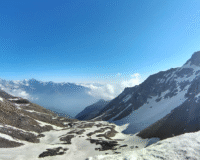I used to believe the mountains were magical. I never imagined that the kind of transformation the ChanderNahan Trek would later bring into my life. Deep down into the Pabbar Valley, deep into Himachal Pradesh, this off-beat trek took me through spell-bound forests, large alpine pastures, and to the pious ChanderNahan Lake—a glacial wonder on the brink of the world.
In retrospect, it wasn’t exactly a trek. It was an inhalation, a recharge, and badly needed chat with nature.
Choosing the ChanderNahan Trek
The choice to undertake the ChanderNahan Trek was almost spontaneous. I required something out of the way, not too touristy, and lots of unspoiled natural beauty. I chanced upon a blog which mentioned this off-beat trail and how it takes you to a high-altitude glacial lake which the locals hold sacred. That was enough. A couple of calls made to a trekking agency, a backpack loaded, and I was off to Shimla, the base for this rugged trek.
The Journey Begins: Reaching Janglik
The ride from Shimla to Janglik was a rough and long one, but that only made it more exciting. When I arrived in Janglik, I was amazed at how the village lived outside of time—stone and wooden houses, cows grazing in fields, and villagers going about their day with a serene rhythm lost in the city.
Evening, with the backdrop of a starry sky, our guide-in-charge briefed us on the days to follow. The ChanderNahan Trek, he informed us, would involve taking us through a marvelous combination of landscape—forests, brooks, and meadows, and eventually to the upper glacial valley where the seven ChanderNahan Lakes are situated.
Day 1: From Janglik to Dayara Thach
The trek started its initial phase with dense oak and pine forests. The route wandered up steadily, and the air was chilly and filled with the aroma of earth and moss. The woods quickly gave way to ascending height, and expansive meadows lay before us. Dayara Thach, our base camp—tract after tract of one continuous expanse of green broken here and there by wildflowers scattered about like confetti.
I recall sitting on a rock that night, with tea in hand, and viewing the clouds cast shadows on hills. It was peaceful. Breathtakingly quiet. Nothing but the susurration of wind and an occasional hooting of a far-off shepherd.
Day 2: Dayara to Litham
The second day brought steeper trails and even more spectacular views. Along our walk, the forests gave way to open glacial-valley floors carved by glacial brooks. Now looming above us were the peaks still capped with snow, their white crests shimmering with sun.
By lunch hour, we arrived at Litham, a stunning and large meadow whose scenery left me awestruck. ChanderNahan waterfall rumbled in the background, off the cliffs, along with melting snow from lakes higher up. We camped next to a gurgling stream. I slept like a child that night, one knocked out by the music of rushing water.
Day 3: Hike to ChanderNahan Lake
This was my day—final push to ChanderNahan Lake. We set out early as the sun glided across snow ridges. The path steepened with loose rocks and snow. At 13,800 feet, air was getting thin, and every step necessitated attention and patience.
It had been a couple of hours since we were on the road when we approached the first of the seven lakes constituting the ChanderNahan basin. The view was just magical—Frosted water shimmering under the grey sky, prayer flags fluttering in the wind. The lake was frozen half the way, which gave it an unreal and virgin appearance.
I sat for hours, sipping the silence. There were no distractions, no cellular network, no sound. Only nature—raw, silent, and majestic.
Why the ChanderNahan Trek is Unique
Whereas the more touristy treks are full of people and usually sanitised versions of the experience, the ChanderNahan Trek is the authentic Himalayan experience. It’s remote, peaceful, and provides an intense spiritual connection with nature. Scenery changes dramatically each day, with a new view around every corner.
This hike also has profound cultural meaning. ChanderNahan Lake is a legendary source of the Pabbar River and a region of profound local religious importance. We were forbidden to touch the lake and instructed to keep quiet in reverence—a poignant reminder that nature and culture are literally intertwined here in these hills.
What I Learned on the Trail
This hike was not merely a physical test. It was a test of silence ability, of giving up electronic distraction, and of noticing the rhythms of the earth once more. I learned how to slow down, how to breathe, and how to pay attention.
I also discovered that sometimes the greatest experiences result not from success or adrenaline but from stillness—by sitting on the shore of a peaceful lake and observing how small, yet how reliant, we are on the world.
Tips for Future Trekkers
If you do go on the ChanderNahan Trek, these are some things I would suggest:
- Acclimatize well: It’s an altitude trek. Spend two days in Janglik or Shimla to acclimatize your body.
- Pack smartly: Layered clothing, a good walking stick, gloves, sunscreen, and a refillable water bottle are a must.
- Be sensitive to local traditions: Locals are friendly and welcoming, but do be sure to respect their beliefs, particularly when in the vicinity of the holy lakes.
- Hike with a guide: The trail is impassable and sometimes unmapped. A first-rate trek guide makes all the difference.
Final Thoughts
ChanderNahan Trek is not just for the seasoned trekker but for anyone who desires tranquility, splendor, and a sense of being one with the Himalayas. It is not the toughest trek but one of the most rewarding. The sense of accomplishment upon reaching the lake, the camaraderie during the trip, and the utter peace of the mountains stay with you long after you return.
Slumped here in my city condo, the din and commotion that surrounds me, I find myself closing my eyes and being transported back to the day at ChanderNahan Lake. I recall the stinging wind, the stillness, and the sense of being utterly, breath-taken alive.






